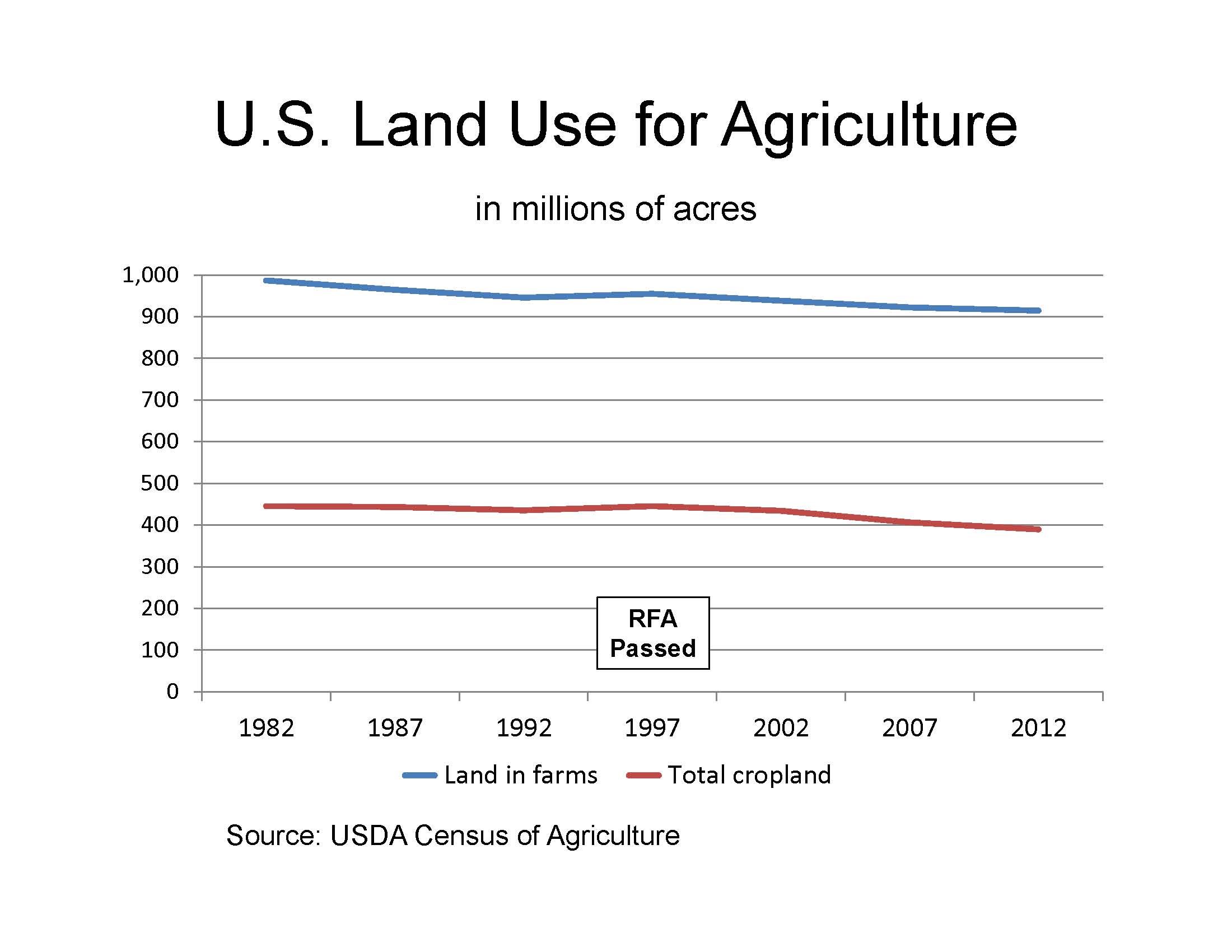Ethanol and the environment
FACT VS FICTION IN THE U.S.
FOR DECADES ETHANOL backers have cited the fuel’s environmental benefits as a renewable resource that reduces air pollution and greenhouse gas (GHG) emissions. So what is an ethanol supporter to think when a well- known organization claims that corn ethanol is worse for the environment than gasoline? Don’t buy it.
TABLE: U.S. LAND USE FOR AGRICULTURE (MILLIONS OF ACRES). SOURCE: USDA CENSUS OF AGRICULTURE.

Recently, the Environmental Working Group (EWG) released a study strongly against ethanol.
“The Environmental Working Group’s bogus study is at odds with a growing body of science,” says Geoff Cooper, vice president for research at the Renewable Fuels Association (RFA). “Numerous analyses conducted since the Environmental Protection Agency published the RFS2 [Renewable Fuels Standard] final rule in 2010 show that corn ethanol reduces GHG emissions by 30 to 40 per cent compared to the gasoline it is replacing.”
Cooper cites multiple research studies of GHG that factor in how land use changes to produce corn for the ethanol process. Work by Purdue University and the Argonne National Laboratory found that corn-based ethanol reduced GHG by an average of 34 per cent. A study by Life Cycle Associates showed corn ethanol could drop GHG by 32 per cent, even when land use changes were part of the equation. The International Food Policy Research Institute found even greater emission reductions — 53 per cent for corn ethanol compared to gasoline.
PEER REVIEWS
Additional peer-reviewed work at the Oak Ridge National Laboratory, Michigan State University, and the University of Illinois supports ethanol’s GHG savings, even when projections for land use changes are factored into the calculation.
The EWG study “cherry-picks” data to argue that ethanol is worse for the environment than gasoline, according to Cooper. Much of the selective data is from a single, five-year-old Environmental Protection Agency (EPA) indirect land use change analysis.
In another example of “cherry picking,” the EWG relies heavily on a land-use paper by C.K. Wright and M.C. Wimberly to argue that ethanol demand is leading farmers to convert native prairie into cropland. The EWG ignores a warning from Wright and Wimberly that their satellite-based study could not tell the difference between a native prairie conversion versus changes involving hay lands, grass pasture, or Conservation Reserve Program (CRP) lands.
“There is no support for the [EWG’s] claim that eight million acres of ‘native’ grassland and wetlands were converted to corn production between 2008 and 2011,” says Cooper, noting that United States Department of Agriculture (USDA) data shows that much of the increase in corn and soybean acres came from land previously planted to hay and pasture.
A slight decline in CRP enrollments as farmers brought idled cropland back into production may have contributed additional acres for corn plantings. Another set of USDA statistics also undercuts EWG claims about land use.
“It demonstrates — quite compellingly — that long-term land use trends have not been interrupted in any meaningful way since the emergence of biofuels,” says Cooper.
The amount of U.S. land in farms and total U.S. cropland have both been declining for decades, according to the Census of Agriculture, which the USDA conducts every five years (see graph).
“If the [Renewable Fuels Standard] is causing cropland expansion and land use change, as EWG ridiculously claims, why does USDA data continue to show fewer acres dedicated to crops,” Cooper asks.
The census numbers conflict with another EWG claim that “forests are being chopped down” as a result of the RFS. Instead, the census shows an increase of 2.5 per cent in total woodlands from 2007 to 2012.
OTHER ERRORS
Cooper and the RFA are not alone in setting the environmental record straight. Researchers from the University of Chicago’s Energy Resource Center and North Carolina State University joined Purdue and Argonne experts to produce a 13-page report detailing EWG errors, such as:
- using an emission factor from converting peat and carbon-rich tropical wetlands to calculate the emissions changes from converting temperate U.S. wetlands, which hold much less carbon;
- using the National Wetlands Inventory to identify converted wetlands though the NWI is based on aerial photographs taken largely in the 1970s and 1980s, decades before the RFS;
- applying a pixel-by-pixel approach to estimate converted acreage though the base data EWG studied is “explicitly not designed to be used for pixel-by-pixel local analyses;
- including wetland buffers in estimates of converted wetland areas;
- and selecting emissions factors from a study published in 2010 that looked at tropical wetlands, instead of more recent grassland- to-cropland conversion factors.
Setting the record straight on ethanol has been an ongoing challenge for RFA, U.S. corn organizations, and other renewable fuels groups that are still working to counter misinformation spread in the 1980s. •







